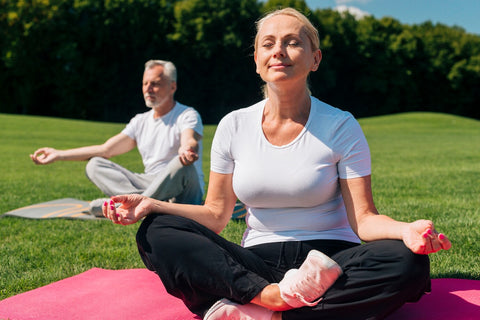More and more health experts and wellness websites are recommending that people over 50 take up yoga. This may be because yoga can help improve flexibility and mobility, enhance balance, delay age-related walking problems, increase energy, relieve chronic pain and addictive behaviors, reduce the risk of heart attacks and strokes, alleviate depression and anxiety, improve sleep quality, and even slow the effects of aging at the cellular level.
According to a survey, the 50-plus age group accounts for 38% of all yoga practitioners, making them the second largest group after those aged 30-49. If you are considering taking up yoga, it is essential to educate yourself on the best way to get started.
Yoga practice for people over 50 is able to understand and work with the differences between younger and more mature bodies , rather than pretending those differences don't exist.
Every body is different and generally becomes less resilient as we age. There is a decline in muscle strength, connective tissue elasticity and bone density, more markedly in women. This combination makes us more vulnerable to injury. Women in menopause, when they lose ovarian function, will stop producing estrogen , which will have repercussions on bone and muscle levels, among others. Bone density decreases sharply during late perimenopause , hence one of the main concerns of menopausal women is the deterioration of bone health. The changes in body composition that occur in women in middle age also affect muscle mass, which unlike fat mass, seems to decrease. Although the decrease in muscle mass associated with age cannot currently be attributed to menopause, it does seem that this degenerative process occurs more quickly after menopause.
Yoga can help women in menopause
Numerous studies have been conducted to date that reflect the usefulness of practicing yoga for mind-body health. The changes that occur during menopause can bring about alterations at the physical and psychological level, so practicing yoga can be considered a good complement for these women.
It is necessary for professionals to be familiar with yoga and to encourage the practice of this technique during menopause for all women due to its benefits for mind-body health and therefore improving the quality of life. Although it is true that yoga does not directly improve vasomotor symptoms such as hot flashes, it can help with insomnia and with the management of stress and anxiety. Which will ultimately have an indirect impact on better emotional and therefore physical well-being.
Taking natural supplements with effective and scientifically proven doses, such as those from Madequa, specific for each of the stages of menopause, can also help you take care of your health in a comprehensive manner. Together with a healthy lifestyle, you will be able to go through this stage with confidence and well-being. And if you still don't know what stage of menopause you are in, you can take our test .
Benefits of yoga
By practicing yoga at home or attending yoga classes at a studio, you will gradually regain flexibility throughout your body , as well as better muscle tone.
The exercise of holding the postures for different periods of time will allow your body to gently strengthen the different muscle chains in a good position.
With regular yoga exercises, the spine and all the muscles surrounding it regain mobility and flexibility . Back pain is reduced and the body becomes straighter, helping you to maintain good posture.
Regular practice of yoga exercises also improves joint flexibility, but above all, it will relieve stress and anxiety.
Yoga is an activity that helps you practice breathing and relaxation exercises, and we know that chronic stress (maintained over time) is a very harmful factor for the health of both women and men.
Yoga can help cope with stress , which greatly influences the onset of menopause . It has been seen that higher levels of cortisol (the stress hormone) result in lower levels of estrogen , which can accelerate the onset of menopause and increase symptoms. It has been shown that those who practice yoga regularly develop a greater tolerance to pain over time, which may be less due to the physical part of yoga practice and more due to the spiritual part and connection with the body and with oneself. The practice of physical exercise, combining strength exercises with aerobic exercises and including yoga or pilates, is a combination that helps to gain muscle mass, avoiding sarcopenia (loss of muscle mass), and at the same time protecting the bones , which is key for women going through menopause, where the risk of osteoporosis (loss of bone density) increases greatly.
In summary, yoga seems to contribute to improving the quality of life, in combination with the practice of other sports as well as with a healthy diet. Even taking supplements can be an excellent option to help with this comprehensive care of women's health, achieving general well-being, especially during menopause when the protective effect of estrogen is lost.
What type of yoga is right for me?
There are many types of yoga. A high-intensity practice such as ashtanga, vinyasa or power yoga usually requires weight-bearing on the hands and is quite dynamic, with numerous transitions. These practices may not be suitable for beginners, especially those who lack athleticism.
Hatha or Iyengar classes , those aimed specifically at middle-aged adults or those focusing on alignment, as well as introductory or approach classes to yoga may be the best option for a first contact.
Kundalini classes , which rely on sitting postures, chanting and breathing work, can also be beneficial.
Yin yoga and restorative yoga (two floor practices that focus on holding poses for long periods of time) and chair yoga (where the chair is used as support in many poses) are great for all types of people, but especially for middle-aged people who are just starting to exercise and may have difficulty finding balance.
The most important thing is to listen to your body and find the practice that best suits your needs, flowing without forcing.
Where? How?
Even within each type of yoga, classes vary greatly depending on the instructor.
Take a look around and get to know different yoga centres and get advice on the different styles:
- Find a teacher who cares about your needs and any injuries or problems you may have and who is interested in making their practice productive for you.
- Find someone who will give you careful instructions, show you postures that seem useful and possible, and offer cues that you can easily interpret.
Explaining your injuries and problems to your instructor is essential , so you can avoid doing movements that may be detrimental to your health. Your instructors will also help you modify postures that may be problematic for you or suggest alternatives.
Know your goals
If instead of achieving goals (such as reaching a certain posture) you see the goal of yoga practice as improving your physical and mental well-being , the postures become less important, becoming more of a means than an end. You will then be less willing to do anything in the short term that could injure you, as this would interfere with your long-term goal.
The benefits that yoga will bring to your well-being do not depend on achieving a more difficult or spectacular posture, nor on going at the pace of the person next to you, nor on practicing a posture the way your teacher does. The benefits derive from a consistent and conscious practice of postures that challenge your range of motion and your strength in a sustainable way over time.
Yoga helps us listen to our bodies and empower ourselves by fostering a deep connection between mind and body . Through the practice of postures (asanas) and breathing techniques (pranayama), we learn to be more aware of our physical and emotional sensations. This awareness allows us to identify and release accumulated tensions, improve our posture and increase our flexibility. At the same time, yoga teaches us to accept our limitations and celebrate our progress , which strengthens our self-esteem and empowers us to face life's challenges with a more balanced and positive attitude .
References
Reed SD, Guthrie KA, Newton KM, Anderson GL, Booth-LaForce C, Caan B, Carpenter JS, Cohen LS, Dunn AL, Ensrud KE, Freeman EW, Hunt JR, Joffe H, Larson JC, Learman LA, Rothenberg R, Seguin RA, Sherman KJ, Sternfeld BS, LaCroix AZ. Menopausal quality of life: RCT of yoga, exercise, and omega-3 supplements. Am J Obstet Gynecol. 2014;210(3):244.e1-11. doi: 10.1016/j.ajog.2013.11.016.
Pachman DR, Jones JM, Loprinzi CL. Management of menopause-associated vasomotor symptoms: Current treatment options, challenges and future directions. Int J Womens Health. 2010;2:123-35. doi: 10.2147/ijwh.s7721.
Afonso RF, Kozasa EH, Rodrigues D, Leite JR, Tufik S, Hachul H. Yoga increased serum estrogen levels in postmenopausal women-a case report. Menopause. 2016;23(5):584-6. doi: 10.1097/GME.0000000000000593.
Motorwala ZS, Kolke S, Panchal PY, Bedekar NS, Sancheti PK, Shyam A. Effects of Yogasanas on osteoporosis in postmenopausal women. Int J Yoga. 2016;9(1):44-8. doi: 10.4103/0973-6131.171717.
Chaturvedi A, Nayak G, Nayak AG, Rao A. Comparative Assessment of the Effects of Hatha Yoga and Physical Exercise on Biochemical Functions in Perimenopausal Women. J Clin Diagn Res. 2016;10(8):KC01-4. doi:10.7860/JCDR/2016/18891.8389
Burke, A. 10 Tips for Starting Yoga After 50. Yoga International. 2020.
García, I. Benefits of yoga during menopause. Menopause Institute.2022.
Laura, V. Benefits of yoga practice during menopause. Literature review. Jan . 2018; 12(1).




Comments (0)
There are no comments for this article. Be the first one to leave a message!